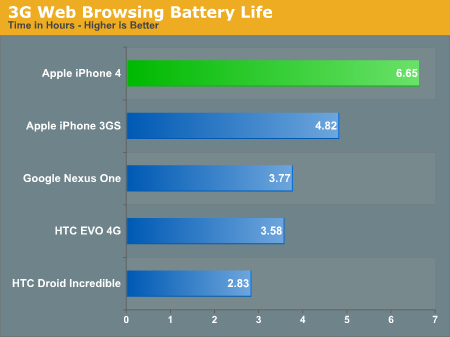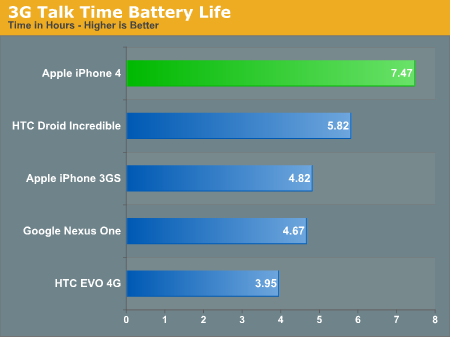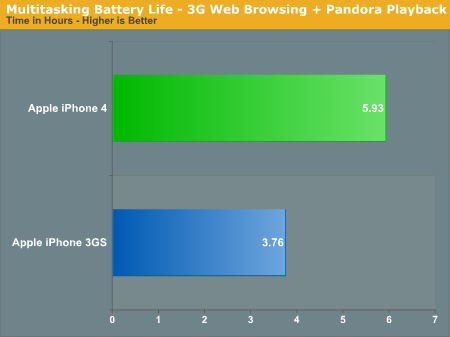Apple's iPhone 4: Thoroughly Reviewed
by Brian Klug & Anand Lal Shimpi on June 30, 2010 4:06 AM EST- Posted in
- Smartphones
- Apple
- iPhone 4
- Gadgets
- Mobile
Incredible Battery Life
I’ve publicly praised Apple for its honesty in reporting battery life over the past couple of years, and the iPhone 4 gives me no reason to stop.
The 4 has an integrated 5.25Whr battery. That’s around 95% of the battery capacity of the HTC EVO 4G, despite having much lower power frequirements. It’s also a 16% increase over the 4.51Whr battery that was in the iPhone 3GS. This means at bare minimum, assuming the iPhone 4 doesn’t draw any more power than the 3GS, we should get 16% more battery life.
In reality, we get much more.
When Apple introduced the iPhone 3G it dropped battery life to a level that we’d been stuck at ever since. The 3GS improved battery life a bit through better CPU power efficiency but you still didn’t have enough juice to get through a day without charging.
The iPhone 4 changes all of that. The combination of a larger battery and a more power efficient SoC results in an incredible amount of battery life.
Our first test is a basic web browsing benchmark. We've scripted almost two dozen webpages to load, pause for 20 seconds, then forward on to the next page. None of the pages use any Flash. This process repeats until the battery is dead. Screen brightness on the iPhones was set to 50% and the screens remained on the whole time.

Battery life improved nearly 38% with the iPhone 4. It's clear that while the A4 improved performance, the real improvement was in battery life. This test has enough idle time where good power management and low idle power can really impact the results. There's simply no other similar smartphone that can touch the 4's battery life.
We then repeated the same test over WiFi instead of 3G:

Apple claims the iPhone 4 will last for up to 10 hours over WiFi, we measured just under that at 9.96 hours. The improvement here is only 12.8%, which tells me that we're nearing the limit of how efficiently Apple can manage power in WiFi mode. There's a wall that we're quickly approaching with this current architecture.
To measure talk time we play MP3s on repeat into the mic of a phone and use it to call the phone being tested. The process continues until the test phone dies. In this case the screen is allowed to go to sleep, as it normally would be if you were talking on the phone:

Apple promised up to 7 hours of 3G talk time with the iPhone 4. We measured 7.47 hours. That's an increase of 54.9% over the iPhone 3GS. While in a phone call the majority of the A4 SoC is powered down, so the efficiency improvements here have to do with how much less power the A4 consumes while off and the new Skyworks 3G modem (the iPhone 3GS used an Infineon modem).
In our iOS 4 review we looked at the impact multitasking had on the iPhone 3GS' web browsing battery life. I ran our 3G web browsing test while playing music through Pandora in the background. I repeated the test with the iPhone 4 for today's article:

We actually see our largest battery life improvement in this test. With a 57.7% increase in battery life over the 3GS, the iPhone 4 is not only more efficient at idle workloads but also when the SoC is constantly busy. The A4 SoC is rumored to be built on a 45nm process compared to the 65nm SoC used in the 3GS. With a moderate increase in clock speed we should be seeing a lot of the power savings that a full node shrink brings to the table.
The battery life offered by the iPhone 4 is spectacular. My iPhone 3GS could hardly get through a full day of work while traveling, I'd always need to hunt for an outlet before heading into my dinner meeting. I'm about to take my first trip with the iPhone 4 but I get the feeling that I might finally be able to make it through dinner.
Early reports of 20 and 30 hours of battery life are simply exaggerated. They're only possible if you let the phone idle in your pocket for the majority of that time. In other words, if you don't use the phone it lasts for a long time. While that's a testament to the platform's incredible idle power, the real world usage is good enough to stand on its own. It's better than any iPhone or Android phone I've tested thus far.










270 Comments
View All Comments
philosofa - Wednesday, June 30, 2010 - link
This kind of in-depth and insightful review is exactly why I read pretty much every Anandtech article (that and a liberal workplace when it comes to browsing lol). Cheers very much Brian & Anand. Don't feel a huge urge to upgrade from my 3GS, but it does look like a pretty damn fine smartphone!quiksilvr - Wednesday, June 30, 2010 - link
Yeah, but he's holding it wrong :(medi01 - Wednesday, June 30, 2010 - link
But guys, who do you pay a fortune for these phones? If you'd buy iphone or whatever phone with 2 year contract in most of Europe you'd pay just the price of the phone over 2 years (a bit more, in case of iphones it's about 700 Euro)I mean, aren't there cheaper contracts? I could imagine, that you can't buy some models other than from mobile providers, but hey, there are other countries with online shops.
Snotling - Thursday, July 1, 2010 - link
In north America and even more in Canada, there is a lot of territory to cover and lower population density. Cellular networks need to plant antennas where there is theoretically too few users to pay for it.JimmiG - Thursday, July 1, 2010 - link
Sweden is kind of like a smaller version of Canada. Apart from the three major metro regions (Stockholm, Malmo and Gothenburg), the country is very sparsely populated. An average city is maybe 50,000 people. Yet we have extremely affordable plans by comparison.. I mean like less than $10 for a perfectly usable plan (1GB of data or so) and no more than $20 for 5GB or even Unlimited. Paying $100 a moth..geez. I barely pay that in a year.Ratinator - Friday, July 2, 2010 - link
Sorry, I think that is a bad comparison.Sweden is 2/3rd the size of the province of Saskatchewan and 9 times the population of Saskatchewan as well. You can't even compare Sweden to the province of Saskatchewan let alone Canada. You have roughly 13.5 times the population density of that province. Mind you this is probably least densely populated of the provinces (not territories) Maybe not the best example, but lets look at a better one.
You could maybe compare to Ontario (our most populated province) however, you are less than half their size with 80% of their population. When calculated out you still have almost twice the population density of our most populated province.
ABR - Monday, July 5, 2010 - link
It's pretty hard to find countries with similar population density to Canada, ranked 228 out of 239 in the world according to wikipedia. On the other hand, most of the country is inaccessible by road and I seriously doubt you are putting up cell towers in Nunavut. On the other hand Finland has half the population density of the United States and yet has similar cellular and broadband rates to Sweden. We don't know what it is with North America, whether a lack of competition, cartel agreements, or all the companies being weighed down by historical investments, but you guys do lead the world in what you pay for communications.Guspaz - Wednesday, October 12, 2011 - link
According to the CIA world factbook (yes, I use a foreign agency's site for info on my own country), 90% of Canada's population lives within 160km of the US border.If we make an estimated measurement and take the southern border's length at 6416 km, multiply that by 160 and you get an area of about a million square kilometres with a population of, adjusting for the 90%, about 31 million. That would be an actual density in that region of about 31 people per square kilometre.
That puts us in 180th place, right behind the US in 179, which has a density of 32. This is close enough to say that, within our populated region, we've got about the same population density as the US.
ripwell - Saturday, July 3, 2010 - link
Are you comparing data plans to voice and data plans? Telia was blasted when the iPhone first came out with some of the most expensive plans in the world. It's pretty amazing if you're suggesting that you can now get voice and data for just $10 a month.JimmiG - Sunday, July 4, 2010 - link
"It's pretty amazing if you're suggesting that you can now get voice and data for just $10 a month. "You rarely get pre-paid minutes here unless you really want to. You just pay about $6 a month and get billed for your minutes afterwards. In my case, it's about 10¢ per minute, but to phones on the same network, you get unlimited texts, mms's and minutes. Yes, for $6 a month. That includes most of my friends and relatives that's pretty much what I pay for voice and texts.
Then on top of that, you can add your data plan, for example 1GB a month at 6Mb is $9 (add $7.8 for 5GB at 10Mb/s).
-Or, if you really must go crazy, you can get 3,000 minutes for $65. Combined with 5GB/month at 10Mb/s, you're paying roughly $82. That's the absolute maximum. No subsidized phone, but you get over 3x more minutes than the iPhone deal and 2.5x the amount of data. The phones aren't really subsidized at all when you look at the total cost.
"You could maybe compare to Ontario (our most populated province) however, you are less than half their size with 80% of their population. When calculated out you still have almost twice the population density of our most populated province. "
But what about the US? Its population density is 32/km2 vs 20.6/km2 for Sweden. There are definitely states that are comparable in size and population density.